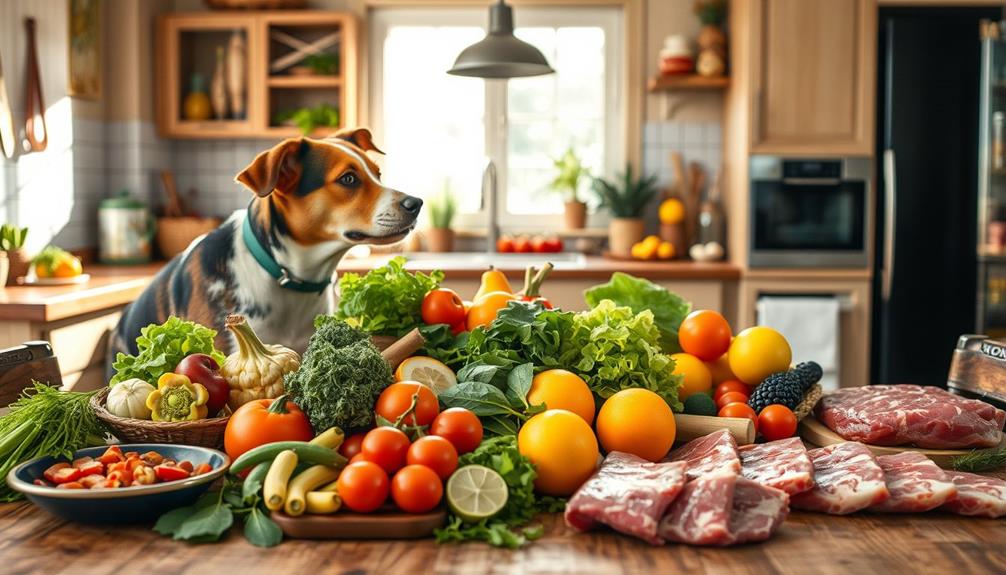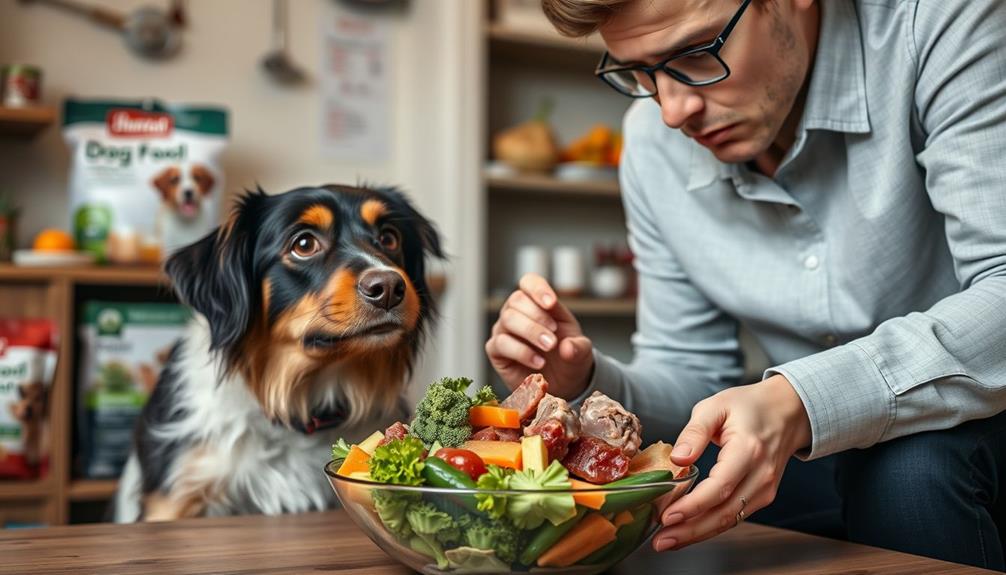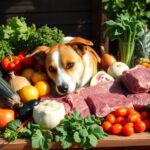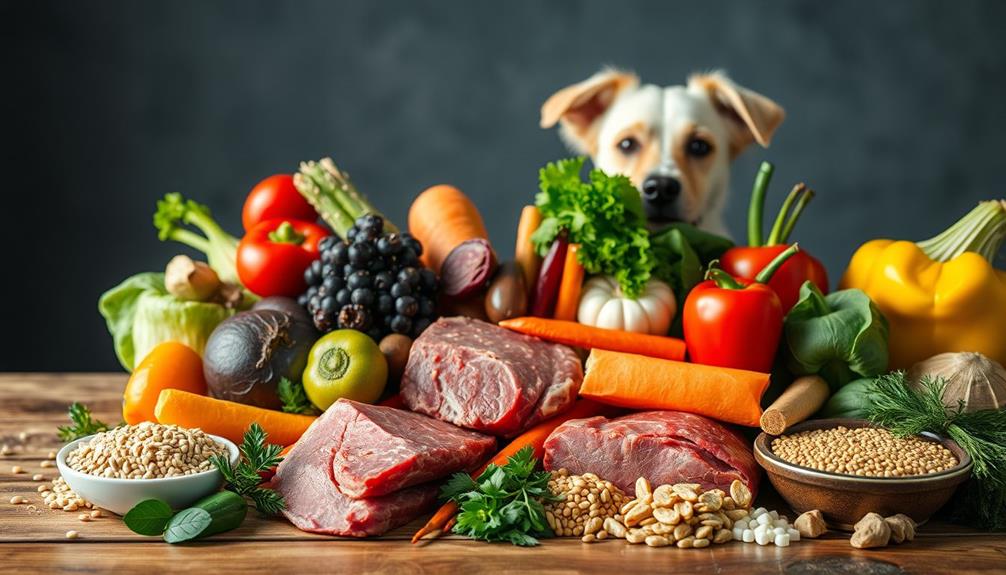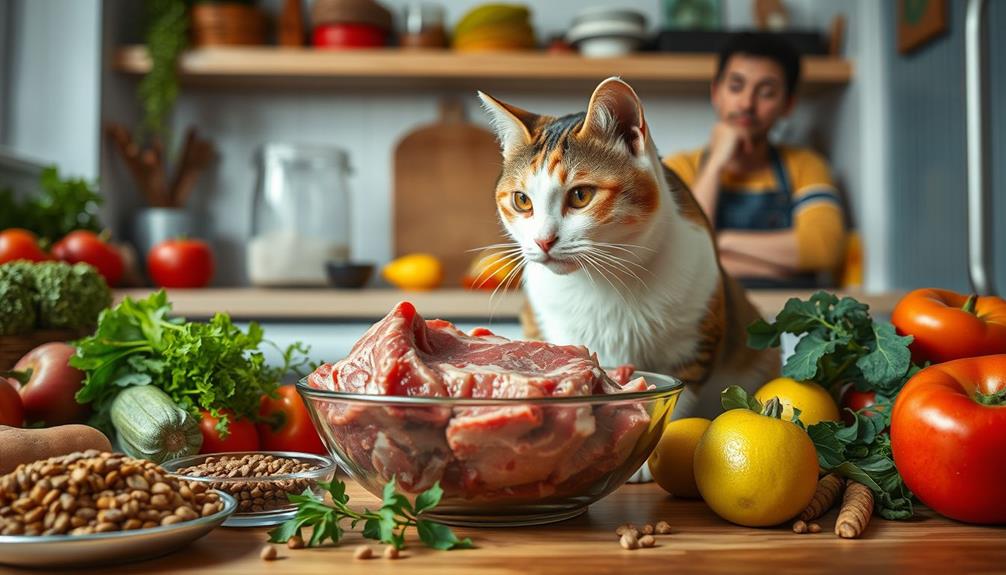Raw food diets can seem appealing for dogs, claiming benefits like shinier coats and better energy levels. However, you must consider the significant health risks involved, such as bacterial contamination from Salmonella and the potential for nutritional imbalances. If you're not careful, your dog could face deficiencies that lead to serious health issues. It's vital to consult a veterinary nutritionist to guarantee a balanced diet tailored to your dog's needs. Good hygiene practices are also essential when handling raw food. To make a well-informed decision for your furry friend, there's more you should explore about raw diets.
Key Takeaways
- Raw dog food can improve coat and skin health, energy levels, and dental hygiene due to its natural ingredients and higher fat content.
- Health risks include bacterial contamination, with about 25% of samples testing positive for harmful pathogens like Salmonella.
- Nutritional imbalances are common in raw diets, making expert consultation essential to meet a dog's dietary needs.
- Hygiene practices are crucial to minimize zoonotic risks when handling raw food, including thorough handwashing and disinfecting surfaces.
- Regular veterinary check-ups are important to monitor health and identify any deficiencies or issues arising from raw feeding.
Overview of Raw Dog Food
Raw dog food is an increasingly popular choice among pet owners looking to mimic the natural diet of their canine companions. Typically consisting of uncooked meat, bones, organs, and dog-safe fruits and vegetables, these raw food diets aim to replicate the ancestral meals of dogs before domestication. Small dogs on raw food may require smaller portion sizes compared to their larger counterparts, and some pet owners may choose to grind up the raw ingredients to make it easier for their small pups to chew and digest. Additionally, it’s important for pet owners to ensure that small dogs on raw food are getting a well-balanced diet that meets their specific nutritional needs, as they may require different quantities of certain nutrients compared to larger breeds. Overall, the decision to feed small dogs a raw food diet should be made in consultation with a veterinarian to ensure that it is a safe and appropriate choice for the individual dog.
The concept gained traction with Ian Billinghurst's BARF (Biologically Appropriate Raw Food) diet introduced in 1993. Many proponents suggest that incorporating natural remedies, like necessary oils for overall wellness, can further enhance a dog's health.
While many advocates of raw dog food claim benefits such as shinier coats, improved skin health, and increased energy, these assertions often lack extensive scientific evidence. Furthermore, it's imperative to be aware of potential health problems associated with feeding your dog a raw diet. Contamination with harmful bacteria like Salmonella and Listeria monocytogenes poses significant risks.
To avoid nutritional deficiencies, it's important to guarantee that raw dog food provides complete and balanced diets. Consulting a veterinary nutritionist can help you navigate these concerns and tailor a diet that meets your dog's specific needs.
If you're considering switching to raw food diets, it's critical to weigh the risks and benefits carefully while seeking expert guidance to keep your furry friend healthy and safe.
Potential Benefits of Raw Diets
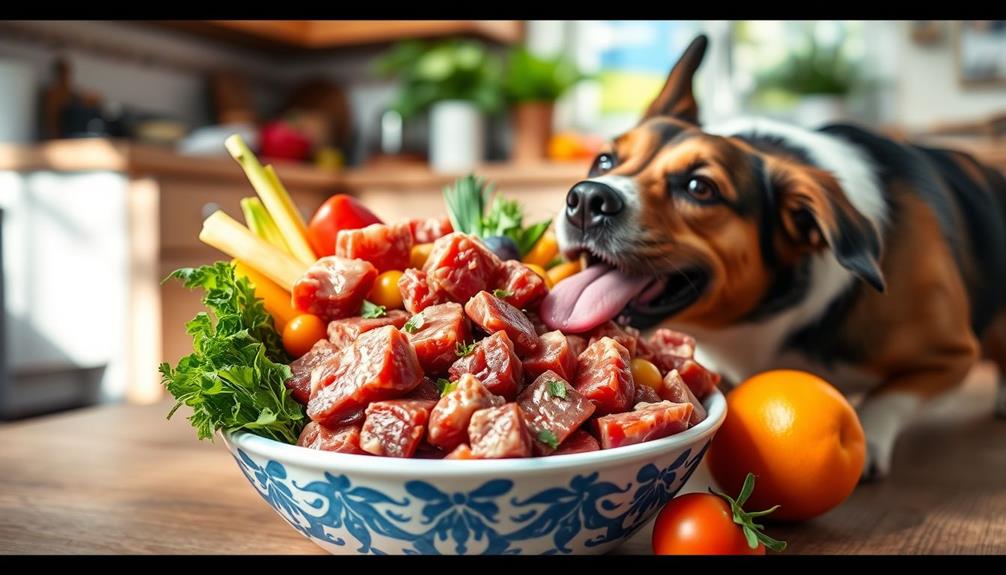
Many dog owners have turned to raw diets, believing they offer several potential benefits for their pets. One of the most commonly noted advantages is the improvement in their dog's coat and skin. Many advocates report a shinier coat and healthier skin, likely due to the higher fat content and natural oils found in raw meat.
Additionally, incorporating fresh ingredients can provide nutritional benefits that may enhance overall health.
Furthermore, some owners have observed increased energy levels and overall liveliness when switching their dogs to a raw diet, aligning with the ancestral dietary patterns of canines. Better dental health is another touted benefit, as the act of chewing raw meat and bones can help reduce plaque buildup compared to traditional kibble.
You may also notice that your dog produces smaller stools, which indicates more efficient digestion and nutrient absorption from the raw diet. This is particularly beneficial for dogs with food allergies or sensitivities, as the inclusion of fresh, whole ingredients can enhance digestive health and tolerance.
Health Risks and Concerns
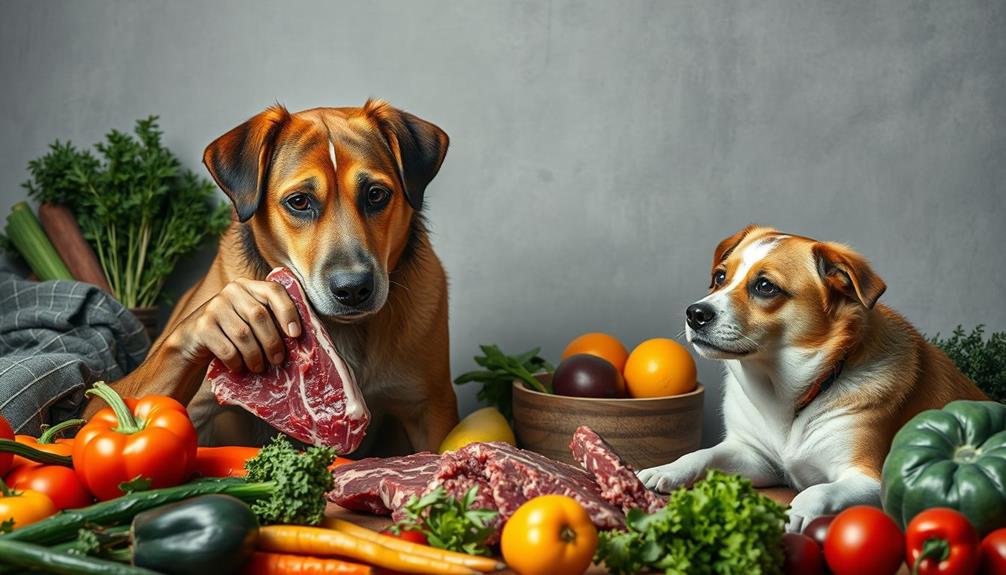
When considering a raw food diet for dogs, it's crucial to understand the potential health risks and concerns that come with it. The CDC and FDA have reported alarming statistics—25% of raw food samples tested positive for harmful bacteria, like Salmonella and Listeria monocytogenes.
These health risks aren't just limited to your dog; Salmonella can lead to severe illness in humans, with symptoms including fever and diarrhea. Dogs can carry this bacteria without showing symptoms, posing risks to everyone in your household.
Additionally, it's important to be aware of the nutritional balance in your dog's diet, as improper feeding can lead to deficiencies consideration of natural remedies alongside conventional medications.
Here are some key concerns to keep in mind:
- Bacterial Contamination: Raw diets can harbor dangerous bacteria, increasing illness risks for both dogs and humans.
- Compromised Immune Systems: Dogs with weakened immune systems are more vulnerable to infections.
- Nutritional Deficiencies: Raw diets often lack essential nutrients, leading to long-term health problems.
- Importance of Hygiene Practices: Proper sanitation and handwashing are critical to minimize zoonotic risks when handling raw food.
Nutritional Balance Challenges
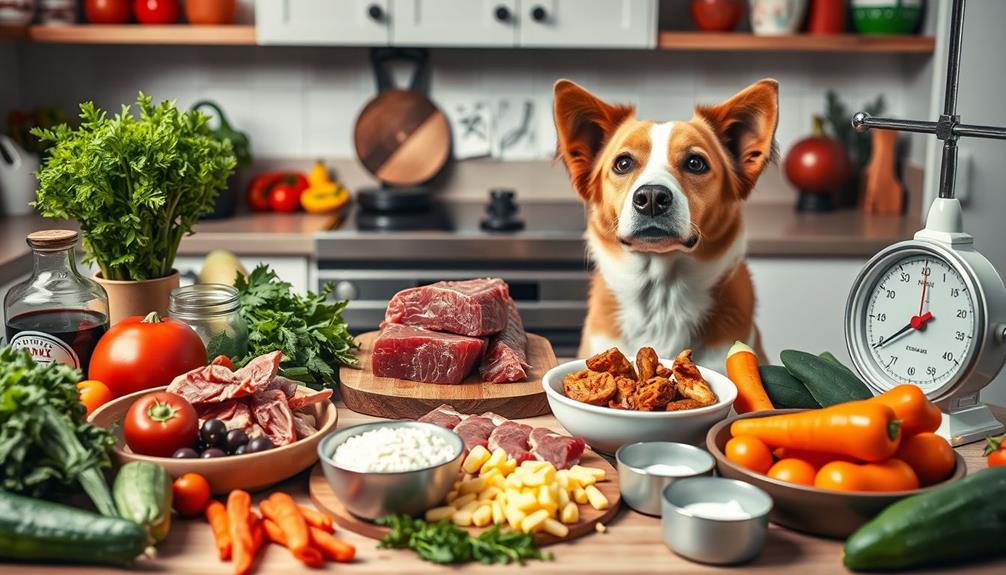
When you consider a raw food diet for your dog, it's essential to think about nutritional balance.
Many raw diets can lead to nutrient deficiencies if they aren't carefully formulated, and balancing macronutrients and micronutrients can be tricky.
Consulting with a nutrition expert can help guarantee your dog gets everything they need for peak health.
Nutrient Deficiency Risks
It's important to recognize that raw diets can lead to significant nutrient deficiencies if not carefully balanced. Many raw diets lack the vital vitamins and minerals necessary for your dog's ideal health, which can be similar to the challenges faced when managing behavioral issues in seniors support resources available.
Nutritional imbalances can arise, particularly concerning calcium and phosphorus levels, which are fundamental for strong bones. The Association of American Feed Control Officials (AAFCO) has established nutrient profiles, yet many raw diets fail to meet these standards, raising concerns about their long-term adequacy.
To help you navigate these risks, consider the following:
- Consult a veterinary nutritionist: They can guide you in formulating a balanced raw diet tailored to your dog's specific needs.
- Research commercially prepared raw diets: Some may not adhere to established guidelines, potentially lacking thorough nutrient coverage.
- Monitor your dog's health: Regular check-ups can help identify any signs of nutrient deficiencies early.
- Educate yourself on nutrient needs: Understanding what vital vitamins and minerals your dog requires will aid in maintaining nutritional balance.
Balancing Macronutrients and Micronutrients
Achieving a balanced intake of macronutrients and micronutrients in a raw food diet for dogs poses significant challenges. Many raw meat-based diets (RMBDs) often lack the balanced macro- and micronutrients necessary for peak health. Without careful formulation, they can lead to nutrient deficiencies that jeopardize your dog's well-being.
Here's a look at some common nutritional challenges:
| Nutrient Challenge | Potential Impact | Solution |
|---|---|---|
| Calcium & Phosphorus | Poor bone development, especially in puppies | Include bone meal or supplements |
| Vitamin Deficiencies | Weak immune system, fatigue | Add fruits/vegetables rich in vitamins |
| Protein Imbalance | Muscle wasting | guarantee a variety of protein sources |
| Inadequate Fiber | Gastrointestinal issues | Incorporate high-quality, fibrous ingredients |
To navigate these nutritional challenges, it's imperative to consult a veterinary nutritionist. They can help you verify that your dog's raw diet includes all necessary vitamins and minerals. Using high-quality ingredients is fundamental for enhancing nutrient absorption. Without proper planning, raw diets may inadvertently expose your dog to significant health risks over time.
Consultation With Nutrition Experts
Maneuvering the complexities of a raw food diet for dogs requires careful consultation with nutrition experts to guarantee nutritional balance. Consulting with a veterinary nutritionist is essential, as they can help you formulate a raw diet that meets AAFCO nutrient profiles, ensuring your dog receives balanced macro- and micro-nutrients.
Many homemade raw diets risk nutritional deficiencies due to missing essential vitamins and minerals, which can harm your pet over time. It's important to recognize that just as individuals with certain disorders, such as Borderline Personality Disorder, can experience challenges in emotional regulation, dogs may also struggle with behavioral issues if their dietary needs aren't met.
Here are four key considerations when working with a nutritionist:
- Nutritional History: Discuss your dog's past diet and health issues to tailor recommendations.
- Financial Constraints: Be transparent about your budget; this helps create a feasible plan.
- Nutritional Adequacy: Your nutritionist will assess whether the proposed diet meets your dog's needs.
- Documentation: Keep a record of all dietary recommendations and decisions for accountability and monitoring.
Safety Practices for Raw Feeding
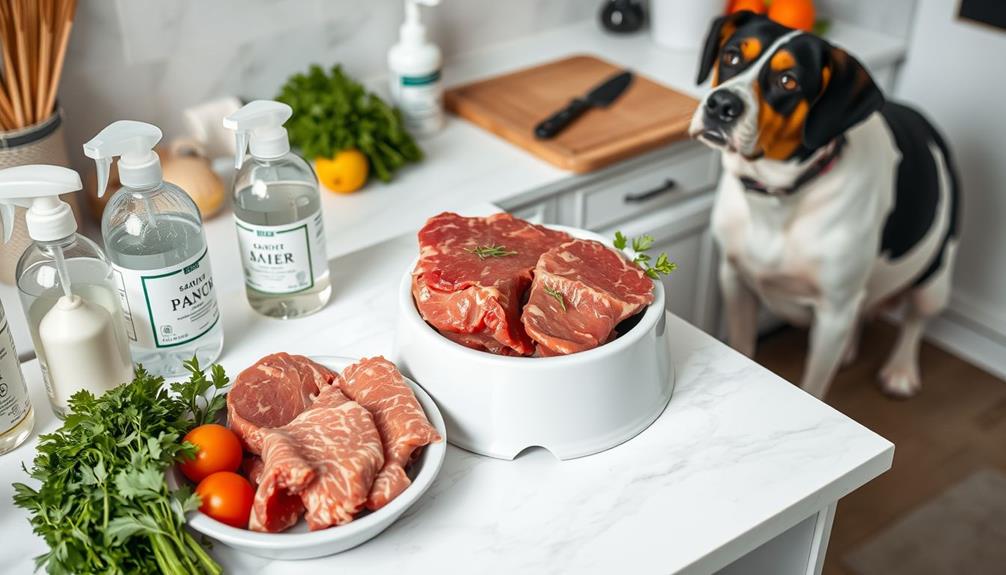
When you're feeding your dog a raw diet, safety should be your top priority.
You need to implement strict hygiene and sanitation practices to prevent bacterial contamination. Proper food storage and preparation techniques are essential to minimize risks, similar to the care taken when handling safe snacks for hamsters.
Hygiene and Sanitation Practices
Maintaining proper hygiene and sanitation practices is essential for anyone feeding their dogs a raw diet, as it helps prevent the spread of harmful bacteria.
Air purifier maintenance dos and don'ts can also be relevant in guaranteeing a clean environment for your pet. By following these guidelines, you can guarantee both your safety and your dog's health:
- Wash your hands: Always wash your hands with soap and water immediately after handling raw dog food to eliminate harmful bacteria like Salmonella and Listeria monocytogenes.
- Disinfect surfaces: Clean and disinfect all surfaces, utensils, and cutting boards that come into contact with raw food to minimize cross-contamination risks.
- Proper storage: Store raw dog food in the freezer until you're ready to use it. Thaw it in the refrigerator or microwave to reduce bacterial growth effectively.
- Use separate equipment: Designate separate dishes and cutting boards exclusively for raw food. This prevents contamination of other food preparations within your household.
Safe Food Handling Tips
Feeding your dog a raw diet can be rewarding, but it's crucial to prioritize safe food handling practices to protect both your pet and your household. It's important to remember that certain foods, like ice cream, can pose health risks to pets if not handled properly; moderation is key ice cream health considerations.
Start by always washing your hands with soap and water after you handle raw dog food. This minimizes the risk of bacterial contamination, as harmful bacteria like Salmonella and Listeria can be present.
Next, clean and disinfect all surfaces, utensils, and cutting boards that come into contact with raw food. This prevents cross-contamination with other foods in your kitchen.
Store raw food in the freezer until you're ready to use it, and thaw it in the refrigerator or microwave. This reduces the growth of harmful bacteria.
Use separate dishes for raw food, and never let it sit out for more than two hours to prevent bacterial proliferation. Refrigerate any leftovers promptly.
If your household includes children, the elderly, or immunocompromised individuals, consider avoiding raw diets altogether due to the increased health risks associated with handling contaminated raw food.
Risks of Bacterial Contamination
Raw feeding can bring many benefits, such as improving coat health and energy levels, but it also carries significant risks of bacterial contamination that pet owners must be aware of.
The CDC and FDA warn that about 25% of raw food samples test positive for harmful bacteria like Salmonella and Listeria monocytogenes. These bacteria can pose health risks not only to your dog but also to your entire household.
To guarantee proper management of your pet's health, consider the role of yoga for back pain in promoting overall wellness.
To help mitigate these risks, follow these safety practices:
- Wash your hands thoroughly after handling raw dog food to prevent bacteria spread.
- Disinfect surfaces that come into contact with raw food to reduce contamination.
- Avoid raw diets if you have young children, elderly, or immunocompromised individuals at home.
- Monitor your dog for any signs of illness, as they can carry Salmonella without showing symptoms.
Veterinary Perspectives on Raw Diets
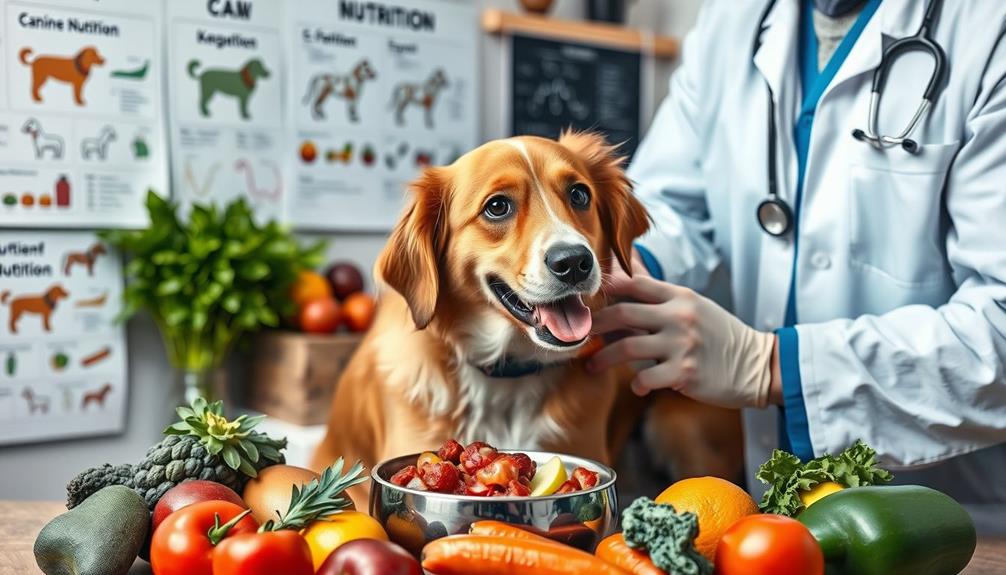
Veterinarians often voice serious concerns about the raw food movement for dogs, primarily due to the heightened risk of bacterial contamination. Studies reveal that about 25% of raw food samples test positive for harmful bacteria like Salmonella and Listeria monocytogenes.
The American Veterinary Medical Association (AVMA) advises against unregulated raw diets, emphasizing the potential health risks to both pets and humans, especially in homes with children or elderly individuals. Additionally, it's important to remember the risks and rewards of Bitcoin IRAs when considering any financial decisions that may impact your ability to care for your pets.
Another vital aspect of veterinary perspectives on raw diets involves nutritional deficiencies. Many raw diets lack the balanced macro- and micro-nutrients essential for a dog's overall health. This gap prompts veterinarians to recommend consulting with a veterinary nutritionist for proper diet planning.
Regular veterinary check-ups are essential for dogs on raw diets, allowing you to monitor their health and address any issues from nutritional imbalances or infections.
Moreover, veterinary facilities often refuse to accept animals on raw diets due to increased disease transmission risks associated with handling and feeding raw food. It's important to weigh these veterinary concerns carefully when considering a raw diet for your dog.
Making Informed Feeding Choices
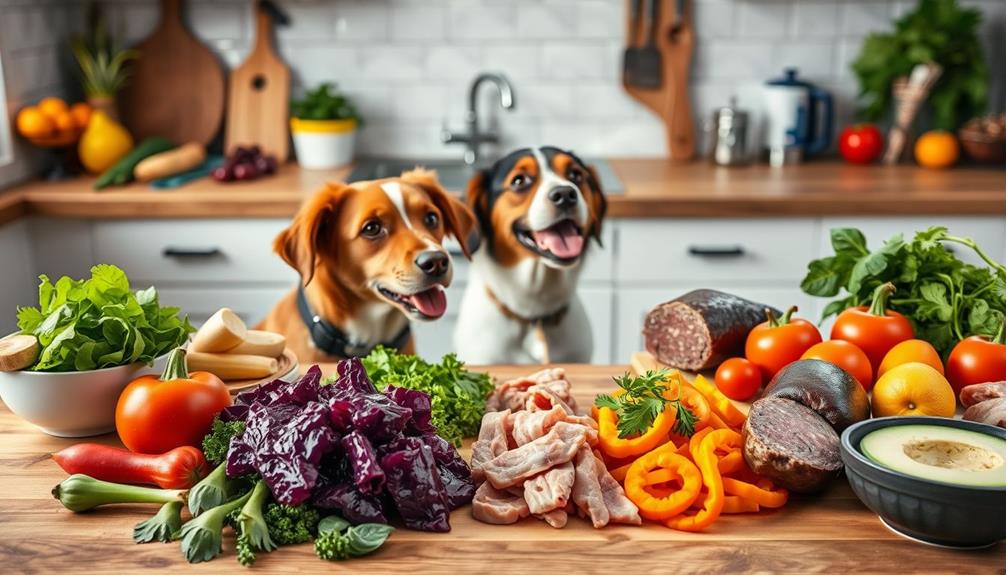
When pondering your dog's diet, it's vital to weigh your options carefully and seek out credible information. A raw food diet might seem appealing, but it's important to evaluate the potential risks and benefits. Here are some points to keep in mind:
- Consult a Veterinary Nutritionist: They can help guarantee your dog's diet has a balanced macro- and micro-nutrient intake, avoiding deficiencies that can harm your pet's health and well-being.
- Be Aware of Harmful Bacteria: The CDC and FDA report that raw food samples often test positive for dangerous bacteria like Salmonella and Listeria, which can affect both dogs and cats.
- Practice Proper Hygiene: When feeding raw food, proper hygiene practices are important. Always wash your hands and disinfect surfaces after handling raw ingredients to reduce contamination risks.
- Regular Vet Check-Ups: Schedule regular check-ups to monitor your dog's health. A poorly balanced raw diet can lead to serious health issues over time, so staying proactive is key.
Frequently Asked Questions
Is Raw Food Actually Better for Dogs?
Whether raw food's better for dogs depends on various factors. You'll need to evaluate your dog's specific health, dietary needs, and potential risks. Consulting a vet can help you make the best choice. Some potential benefits of raw food diets for dogs include improved digestion, shinier coats, and increased energy levels. However, there are also risks associated with raw food diets, such as potential exposure to harmful bacteria and a lack of essential nutrients. It’s important to carefully weigh the pros and cons and consider your dog’s individual needs before making a decision about whether to switch to a raw food diet. Consulting a vet can provide valuable insight and guidance in making the best choice for your furry friend.
Do Vets Recommend a Raw Diet for Dogs?
While some pet owners might be drawn to the allure of raw diets, most veterinarians recommend against them. They emphasize balanced, commercially prepared options to guarantee your dog's health and well-being, avoiding potential risks.
What Are the Disadvantages of Raw Food for Dogs?
Raw food diets for dogs can pose serious risks, including bacterial contamination, nutritional deficiencies, and choking hazards. You should weigh these disadvantages carefully before deciding if a raw diet is the right choice for your pet.
How Do I Make Sure Raw Food Is Safe for My Dog?
"An ounce of prevention is worth a pound of cure." To keep raw food safe for your dog, always wash hands, use separate utensils, store food correctly, and consult a vet for balanced nutrition.
Conclusion
In the end, choosing a raw food diet for your dog can feel like walking a tightrope—balancing benefits and risks. While the allure of fresh, unprocessed meals dances like sunlight on water, it's essential to stay grounded in knowledge and safety. With careful planning and veterinary guidance, you can navigate this path with confidence. So, listen to your pup's needs, and make feeding choices that nurture their health and happiness, turning mealtime into a joyful celebration.

